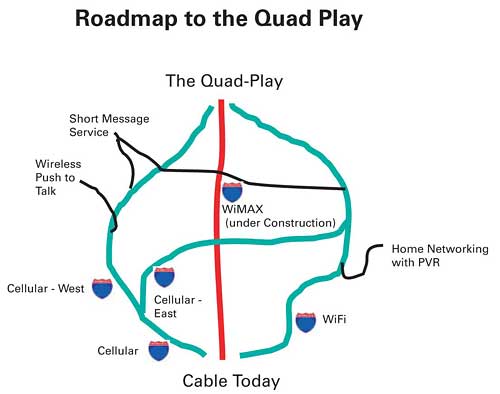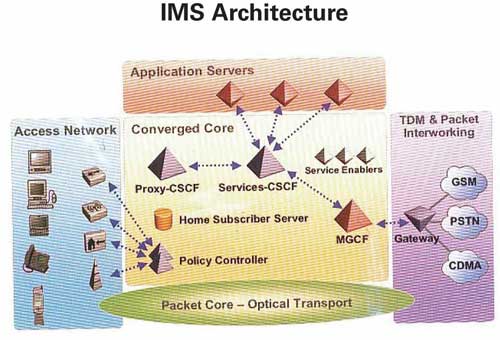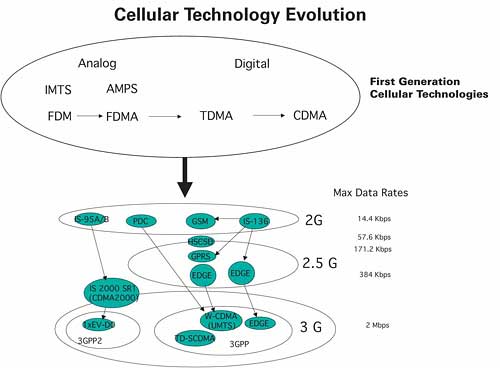Road Tripper's Guide to Wireless Convergence
When you need to cut through the choices that lead to adding mobility-based services, it helps to build a down-to-earth analogy. As summer winds down, perhaps a road trip might sort things out. Mapping the way The endpoint is often, if imprecisely, called the quad-play, a term that confuses types of services (video, voice, data) with a form of signal transmission (wireless). Let’s run with this common notion all the same and imagine, moreover, what a road trip would look like if that were the destination. (See Figure 1.) The interstate highways are WiMAX, cellular and Wi-Fi technologies with off-ramps leading to service offerings. Although these tech expressways traverse different routes, their off-ramps often lead to the same service offerings. Side excursions are chosen based upon tradeoffs such as long term revenue or rapid market penetration. A PacketCable-compliant network is the car for cable’s road trip to the quad play. It comes pre-equipped with the embedded multimedia terminal adapters (EMTAs), cable modems, cable modem termination systems (CMTSs), and public switched telephone network (PSTN) gateways. Most of the options that make it possible to reach the destination are aftermarket accessories since they won’t be available until you hit the road. Many premier options are included as part of the Internet protocol multimedia subsystem (IMS) package. A needed accessory Most visionaries agree that an IMS core will be an essential part of cable’s migration to seamless wireless offerings. IMS is part of a new architecture created by the wireless Third Generation Partnership Program (3GPP) to interface IP technology with evolving digital wireless networks. One of the key motivations for this architecture is to make it easier to create new services that bridge multiple technologies and access types. For example, simple messaging service (SMS) is an extremely popular mobile telephone feature, but current implementations generally limit it to mobile phones. With IMS, the software defining the application resides in applications servers that can interface with multiple network platforms, including cable networks. Most importantly, IMS builds and supports applications independent of access technologies, which means that cable and wireless providers can leverage services created for other markets. The main components of an IMS core are one or more call session controller functions (CSCFs), a home subscriber server (HSS), one or more policy controllers, a media gateway controller function (MGCF), and service enablers. (See Figure 2.) The HSS is essentially a database manager that keeps track of who and where you are. The CSCF is a session initiation protocol (SIP) server that manages all the SIP signaling used to control the IMS network. Policy controllers provide policy enforcement and billing capabilities for specific access networks. For a DOCSIS network, that role is handled by the PacketCable Multimedia (PCMM) policy server. The MGCF manages communications with other networks, including the PSTN. Part of that function in PacketCable is fulfilled by the media gateway controller (MGC). Service enablers are common software-based attributes that are used by several applications. An example is the presence enabler, which keeps track of who and where you are. Although IMS is not currently part of PacketCable, PacketCable’s distributed architecture makes it possible to incorporate whatever components of IMS make sense for a wireless migration strategy. There are a lot of similarities in both architectures. Glenn Russell, CableLabs director of multimedia applications, noted that "2.0 has an overall goal of convergence. We are looking at ways to consolidate device IDs such that a connection is identified with an individual. Also, IMS has a SIP-based core, and 2.0 is headed in the same direction." Commercial availability of IMS network elements will most likely begin near the end of this year, but for now, most IMS activity is trials and network element testing. Lucent, Nortel and Siemens all have IMS solutions in various stages of development, generally building upon existing network elements. Elaine Smiles, Nortel marketing director for cable MSO solutions, points out how this works. "In the Succession 2000, we already have an MGC, which evolves into the MGCF," she says. "Likewise, the existing CMS will become an IMS application server. We have a home location register (HLR) for our cellular customers, and it has evolved into an IMS HSS. Although the CSCF is a new network element, it will communicate with applications servers and the MGCF via the IMS service control (ISC) protocol." The highway system If IMS is part of the car that cable uses to get to the quad play, the highways traveled by that car will be the various air interfaces defined by wireless standards. In general, these standards can be grouped into three categories: Wi-Fi, cellular and WiMAX. Each has evolved from specific market needs, and markets will continue to play a big role in determining which technology path an operator will follow. Wi-Fi is commonly used as shorthand to refer to implementations of the Institute of Electrical and Electronics Engineers 802.11 a, b, and g standards for wireless local area networks (WLANs), although technically, the term refers to interoperable Wireless Communications Association-certified solutions built from those standards. Out of the 802.11x standards, a and b came first. B is a single carrier system that achieved 11 Mbps of capacity by an efficient coding scheme rather than multibit modulation. Orthogonal frequency division multiplexing (OFDM) was chosen as the modulation method for a to achieve 54 Mbps throughput, and after considerable debate, was also chosen for g, not so much for a higher data rate, but for its ability to overcome the noisy nonlicensed 2.4 GHz spectrum. Because they operate at different frequencies, a and g are not directly compatible with b-network cards that provide both use two radios. One of the biggest limitations to 802.11 is a 50-meter maximum distance at 54 Mbps. Wi-Fi’s applications are data-oriented. Cable’s current involvement with these technologies is in the early stages and focuses on home networks and in-home wireless extensions for high-speed data service. Future uses may include voice over IP (VoIP) and wireless streaming video within home networks. Cellular technology, unlike Wi-Fi, was originally designed for voice mobility beyond a home or business, with telephony as the first application. Its roots are in analog, time division multiple access (TDMA)-based systems, which are now largely eclipsed by more spectrum-efficient digital systems. Currently between the third generation (from which comes the 3G in 3GPP) and an evolving fourth generation, cellular technology iterations have generally been motivated by the need for increased capacity. The first motivation was increased channel capacity for more voice calls per tower, but 3G efforts have been to increase data throughput to where Internet browsing and full-motion video could become practical offerings. Figure 3 shows the pedigree of these technologies. Seamless cellular integration with cable may turn out to be Wi-Fi’s "killer" application. At the National Cable Show earlier this year, Jay Strater, Motorola senior systems engineer, traced a possible path that depends upon an IMS core, dual mode cellular handsets and a wireless residential gateway. Dual mode handsets would communicate with both cellular mobile switching centers (MSCs) and customer premises-based WLANs. Within the WLAN, VoIP is provided via SIP signaling and real time protocol (RTP) traffic between the dual-mode handset and call control elements in an IMS core network. The same applies if a dual-mode handset is in a 3G cellular network that supports VoIP over its data network. When a handset is in a circuit-switched cellular network, circuit-switched signaling and voice are converted to SIP signaling and RTP at an IMS signaling and media gateway respectively. Dual-mode handset and landline inter-working is expected to be the subject for Phase 2 of the PacketCable 2.0 cellular integration initiative. WiMAX is, for now, an unknown path in cable’s journey. The underlying standard for WiMAX is IEEE 802.16. Like Wi-Fi, WiMAX is a label that indicates certification for interoperability by an association, in this case the WiMAX Forum. In addition to user bandwidth data rates comparable to Wi-Fi and 10 times Wi-Fi distance coverage, 802.16 provides improved noise immunity because of fast file transfer (FFT) OFDM and improved latency performance through the use of slotted TDMA at the media access control (MAC) layer. One of the issues with moving from vendor-specific 802.16 to interoperable WiMAX is agreement on which frequencies will be used. Spectrum availability varies from country to country, and operation in unlicensed spectrum requires additional consideration of interference. In the United States, the most likely bands are 2.5, 3.5 and 5 GHz. The fixed point-to-point characteristic of 802.16-2004 limits near term possibilities for cable to commercial wireless plant extensions, and even these would most likely not be DOCSIS-based because of substantial differences between the physical (PHY) and MAC layer implementations of DOCSIS and WiMAX. Although no WiMAX-certified product has shipped as of mid-’05, vendors are offering implementations of the near-WiMAX and 802.16-2004 version of the standard. Motorola has been offering Canopy since the late 1990s and has announced a WiMAX product for the European licensed 3.5 MHz market for the 2006 timeframe. Alvarion and Redline Communications also have products. The greatest promise for WiMAX is in the 802.16e version of the standard, which features mobility and greater capacity than 3G cellular technology. WiMAX visionaries at Supercomm this year painted a picture of handhelds, laptops and cell phones communicating multimedia, including full motion video, over a single standard link. This vision is supported by Intel’s commitment to include WiMAX chips in laptops shipping in 2007. Although such a universal untethered link would obviously compete with wired broadband alternatives, limitations on throughput as the number of users per WiMAX channel increases and the need to find a workable solution for roaming beyond a single tower’s range makes it apparent that there will continue to be a need for higher capacity landline-based broadband to adequately handle high quality streaming video and data. Get a move on Given the number of choices for service implementations, there are indeed several routes to the quad play. It is therefore critical for cable operators to build a market-based strategy driven by services to help choose the optimum route for their company. Otherwise, as Lewis Carroll once said, "If you don’t know where you are going, any road will take you there." Justin J. Junkus is president of Knowledgelink and telephony editor for Communications Technology. Reach him at jjunkus@knowledgelinkinc.com. Figure 1  Figure 2
Figure 2  Figure 3
Figure 3 